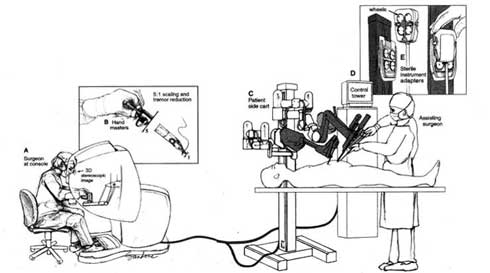
Robotic Prostatectomy Surgery
A robotically assisted laparoscopic radical prostatectomy utilizes the da Vinci™ Surgical System. The da Vinci™ System is a computer enhanced, minimally invasive surgical tool controlled by the surgeon.
The patient side cart sits at the bedside and holds the 4 robotic arms. The console is an ergonomically designed device that allows the surgeon’s movements to be translated into action utilizing the robotic arms. The robotic arms utilize EndoWrist™ instruments that have more degrees of freedom and precision than the human wrist.
How is Robotic Prostatectomy Surgery Performed

A robotic prostatectomy is performed through small laparoscopic ports. Typically, five ½ to 1 inch keyhole incisions are made in the abdomen for introduction of the laparoscopic ports. The traditional surgical approach uses a larger incision from just below the umbilicus to the pubic bone. The abdomen is inflated with carbon dioxide gas to create a surgical working space. The surgeon operating the robot controls the camera and 3 separate mechanical arms inserted through the laparoscopic ports. The surgeon at the bedside works through the 5th port providing exposure and introducing and removing suture and surgical clips.
In The surgical team then removes the lymph nodes and the prostate and reconstructs the urinary tract in a manner similar to the traditional open approach.
Who is the Candidate for Robotic Prostatectomy Surgery?
• Most men with localized prostate cancer are candidates for Robotic prostatectomy surgery.
• The ideal candidate for robotic prostatectomy is a younger man in good physical health with little co-morbidity, a small prostate, and a lower-grade, low-volume tumor.
Generally, men with Gleason scores of 8, 9, or 10, and/or advanced stage T3-T4 disease would not be considered due to risk of cancer extension beyond the prostate.
What is the Success Rate of Robotic Prostatectomy Surgery?
Robotic prostatectomy surgery has the highest success rate among all prostate cancer treatment options. Success rates for a robotic prostatectomy can range from 30 - 98%. Studies have shown success rates between 80 to 98%. The experience of the surgeon performing the surgery is an important fact, i.e. surgeons have greater success and lower complications rates if they routinely perform the procedure.

• Minimal Bleeding Faster return to normal daily activities .
• Reduced hospital stay Significantly less pain and scarring
• Lower blood transfusion rates
• Improved preservation of physical appearance.
• Three (3) D vision enables surgeon to perform Prostate excision with Cancer.
• Lower blood transfusion rates
• Control without risk of Post Surgery Continence (control over urinary and fecal discharge) and causing Impotency
What is Da Vinci Master Slave Robotic System?
Da Vinci master slave robotic system is used to completely eradicate cancer with minimal side effects for treating Prostate Cancer. Through this system a minimally invasive robot assisted radical prostatectomy technique has been developed in which doctors evolved a unique sequence of surgical steps.
The Da Vinci is a sophisticated master-slave robot that incorporates 3-D high definition visualization, scaling of movement, and wristed instrumentation.
The operations with the Da Vinci System are performed with no direct mechanical connection between the surgeon and the patient. The surgeon is working a few feet away from the operating table, while seated at a computer console with a three-dimensional view of the operating field
About MyMedOpinion.com
MyMedOpinion affiliated Best hospitals in India provide an
medical opinion from experienced surgeons and the treatment cost includes
companion stay , surgeon fee, medicines and consumables, nursing care,
patient's food and airport pick up & drop etc. etc. We offer free, no
obligation assistance to international patients to find world class medical
treatment in India. We offer support and services to facilitate the care you
require. We can help you find the best hospital in India
Send us a Medical Report to Get FREE Medical Opinion from India's
Top Doctors
MyMedOpinion.com is the hub of Surgeons and specialists for
major diseases. We give you a chance to speak to our doctors and discuss your
health issues directly.
Email Us: Free@mymedopinion.com
Call Us: +91-7503537224


.jpg)
.jpg)




